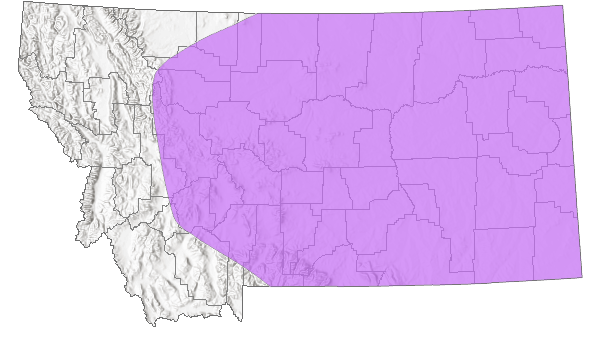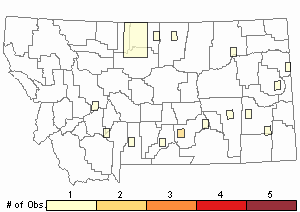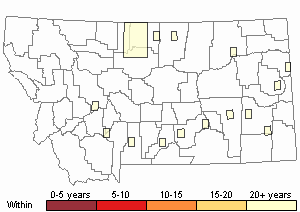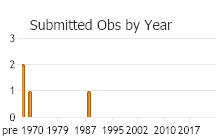View in other NatureServe Network Field Guides
NatureServe
Montana
Utah
Wyoming
Idaho
Wisconsin
British Columbia
South Carolina
Yukon
California
New York
Obscure Grasshopper - Opeia obscura
General Description
The following comes from Hebard (1928), Brooks (1958), Helfer (1971), Otte (1981), Capinera and Sechrist (1982), Vickery and Kevan (1985), McDaniel (1987), Pfadt (2002), Capinera et al. (2004), and Scott (2010). A small to medium size pale brown, yellow, or green grasshopper. The antennae are sword-shaped (ensiform). A dark stripe extends from the back of the eye across the top of the lateral lobe of the pronotum and onto the forewings (tegmina). A dark stripe may occur on the dorsal median of the pronotum. The hind tibia is pale tan, bluish-green or gray.
Phenology
Overwinters in the egg stage. Nymphs appear in June, and adults occur from late July or August into October (Capinera and Sechrist 1982, Capinera et al. 2004, Otte 1984, Pfadt 2002, Scott 2010, and Vickery and Kevan 1985).
Diagnostic Characteristics
The following is taken from Hebard (1928), Brooks (1958), Helfer (1971), Otte (1981), Capinera and Sechrist (1982), Vickery and Kevan (1985), McDaniel (1987), Pfadt (2002), Capinera et al. (2004), and Scott (2010). Male body length is 13 mm to 15 mm, and females 18 mm to 20 mm. Wing length usually extending to near the tip of the abdomen but can vary. The forewings have a longitudinal, dark brown stripe, broken into spots in the center and a white stripe below. The outer face of the hind femur has a dark stripe on the upper surface and is not banded.
Can be confused with the
Striped Slant-faced Grasshopper (
Amphitornus coloradus),
Velvet-striped Grasshopper (
Eritettix simplex), and the
Meadow Grasshopper (
Chorthippus curtipennis). Refer to those species for diagnostic comparisons for determining positive identification.
Species Range
Montana Range
Range Descriptions

 Native
Native
Range Comments
The Obscure Grasshopper is widely distributed across the the Great Plains’ grasslands. Distributed from inland California eastward to western Minnesota, Nebraska, Kansas, Oklahoma, and Texas, north from southern Alberta, Saskatchewan, and Manitoba, southward deep into central Mexico. In Montana, it has been reported for 32 counties (probably occurs in more) in the eastern two-thirds of the state (Capinera and Sechrist 1982, Capinera et al. 2004, Otte 1984, Pfadt 2002, Scott 2010, and Vickery and Kevan 1985).
Observations in Montana Natural Heritage Program Database
Number of Observations: 16
(Click on the following maps and charts to see full sized version)
Map Help and Descriptions
Relative Density

Recency


 (Observations spanning multiple months or years are excluded from time charts)
(Observations spanning multiple months or years are excluded from time charts)
Habitat
Inhabits shortgrass and mid-grass prairies in areas of sparse vegetation, poor soils and eroded ground (Capinera and Sechrist 1982, Otte 1984, Pfadt 2002, and Vickery and Kevan 1985).
Food Habits
The following comes from Capinera and Sechrist (1982), Capinera et al. (2004), Pfadt (2002), Schell et al. (2005), and Vickery and Kevan (1985). This species is primarily a grass feeder, preferring
blue gramma (
Bouteloua gracilis) and
buffalograss (
Munroa squarrosa) which can make up 85 to 100 percent of its diet (consumed by both nymphs and adults). However, nineteen other grass species are known to be consumed in lesser amounts, including
Needle-and-Thread (
Stipa comata),
sand dropseed (
Sporobolus cryptandrus),
little bluestem (
Schizachyrium scoparium), and
western wheatgrass (
Elymus smithii). In addition, studies have observed this species consuming trace amounts of threadleaf sedge, needleleaf sedge, eight species of forbs, fungi, and arthropod body parts.
Reproductive Characteristics
No studies of the Obscure Grasshopper’s courtship and mating behavior have been made. Females oviposit their eggs deep into bare soil near its preferred food plants. They lay 8 to 10 eggs in a pod arranged in two columns. The nymphs pass through 5 instars before reaching the adult stage (Capinera and Sechrist 1982, Pfadt 2002, Schell et al. 2005, and Vickery and Kevan 1985).
Management
The Obscure Grasshopper can reach high population densities which makes it a potential pest species on rangeland forage, but its reproductive potential is less than most other grasshopper species considered pests (Capinera and Sechrist 1982, Pfadt 2002, and Schell et al. 2005).
References
- Literature Cited AboveLegend:
 View Online Publication
View Online Publication Brooks, A.R. 1958. Acridoidea of Southern Alberta, Saskatchewan, and Manitoba (Orthoptera). The Canadian Entomologist (Supplement 9) 90:5-92.
Brooks, A.R. 1958. Acridoidea of Southern Alberta, Saskatchewan, and Manitoba (Orthoptera). The Canadian Entomologist (Supplement 9) 90:5-92. Capinera, J.L. and T.S. Sechrist. 1982. Grasshoppers of Colorado: Identification, Biology, and Management. Fort Collins, CO: Colorado State University Experiment Station, Bulletin 584S. 161 p.
Capinera, J.L. and T.S. Sechrist. 1982. Grasshoppers of Colorado: Identification, Biology, and Management. Fort Collins, CO: Colorado State University Experiment Station, Bulletin 584S. 161 p. Capinera, J.L., R.D. Scott, and T.J. Walker. 2004. Field Guide to Grasshoppers, Katydids, and Crickets of the United States. Ithaca, NY. Cornell University Press.
Capinera, J.L., R.D. Scott, and T.J. Walker. 2004. Field Guide to Grasshoppers, Katydids, and Crickets of the United States. Ithaca, NY. Cornell University Press. Hebard, M. 1928. The Orthoptera of Montana. Proceedings of the Academy of Natural Sciences of Philadelphia, Vol. 80:211-306.
Hebard, M. 1928. The Orthoptera of Montana. Proceedings of the Academy of Natural Sciences of Philadelphia, Vol. 80:211-306. Helfer, J.R. 1971. How to Know the Grasshoppers, Crickets, Cockroaches, and Their Allies. Revised edition (out of print), Mineola, NY: Dover Publications.
Helfer, J.R. 1971. How to Know the Grasshoppers, Crickets, Cockroaches, and Their Allies. Revised edition (out of print), Mineola, NY: Dover Publications. McDaniel, B. 1987. Grasshoppers of South Dakota. Brookings, SD: South Dakota Agricultural Experiment Station, Bulletin TB 89.
McDaniel, B. 1987. Grasshoppers of South Dakota. Brookings, SD: South Dakota Agricultural Experiment Station, Bulletin TB 89. Otte, Daniel. 1981. The North American Grasshoppers. Volume 1. Acrididae (Gomphocerinae and Acridinae). Harvard University Press. 275 pp.
Otte, Daniel. 1981. The North American Grasshoppers. Volume 1. Acrididae (Gomphocerinae and Acridinae). Harvard University Press. 275 pp. Pfadt, R.E. 2002. Field Guide to Common Western Grasshoppers, 3rd edition. Laramie, WY: Wyoming Agricultural Experiment Station, Bulletin 912, modified by S. Schell and S. Schell for electronic publication. Accessed 19 February 2020. http://www.uwyo.edu/entomology/grasshoppers/field-guide/index.html#fieldguidetoc
Pfadt, R.E. 2002. Field Guide to Common Western Grasshoppers, 3rd edition. Laramie, WY: Wyoming Agricultural Experiment Station, Bulletin 912, modified by S. Schell and S. Schell for electronic publication. Accessed 19 February 2020. http://www.uwyo.edu/entomology/grasshoppers/field-guide/index.html#fieldguidetoc Schell, S.P., A.V. Latchininsky, and B.A. Shambaugh. 2005. Common Wyoming Pest Grasshoppers. 2nd Edition B-1161.Laramie, WY: University of Wyoming Cooperative Extension Service and Department of Renewable Resources. 76 p.
Schell, S.P., A.V. Latchininsky, and B.A. Shambaugh. 2005. Common Wyoming Pest Grasshoppers. 2nd Edition B-1161.Laramie, WY: University of Wyoming Cooperative Extension Service and Department of Renewable Resources. 76 p. Scott, R.D. 2010. Montana Grasshoppers, Katydids, and Crickets A Pictorial Field Guide to the Orthoptera. MagpieMTGraphics, Billings, MT.
Scott, R.D. 2010. Montana Grasshoppers, Katydids, and Crickets A Pictorial Field Guide to the Orthoptera. MagpieMTGraphics, Billings, MT. Vickery, V. R. and D. K. M. Kevan. 1985. The grasshopper, crickets, and related insects of Canada and adjacent regions. Biosystematics Research Institute, Ottawa, Ontario. Publication Number 1777. 918 pp.
Vickery, V. R. and D. K. M. Kevan. 1985. The grasshopper, crickets, and related insects of Canada and adjacent regions. Biosystematics Research Institute, Ottawa, Ontario. Publication Number 1777. 918 pp.
- Additional ReferencesLegend:
 View Online Publication
View Online Publication
Do you know of a citation we're missing? Anderson, N.L. 1951. Field studies on the biology of range grasshoppers of southeastern Montana. M.Sc. Thesis. Bozeman, Montana: Montana State University. 96 p.
Anderson, N.L. 1951. Field studies on the biology of range grasshoppers of southeastern Montana. M.Sc. Thesis. Bozeman, Montana: Montana State University. 96 p. Anderson, N.L. 1962. Grasshopper-vegetation relationships on Montana grasslands. Ph.D Dissertation. Bozeman, Montana: Montana State University. 73 p.
Anderson, N.L. 1962. Grasshopper-vegetation relationships on Montana grasslands. Ph.D Dissertation. Bozeman, Montana: Montana State University. 73 p. Gillespie, R.L.1992. Dynamics of grasshoppers (Orthoptera: Acrididae) at a rangeland-crop interference. Ph.D. Bozeman, MT: Montana State University. 111 p.
Gillespie, R.L.1992. Dynamics of grasshoppers (Orthoptera: Acrididae) at a rangeland-crop interference. Ph.D. Bozeman, MT: Montana State University. 111 p. Hebard, M. 1932. Notes on Montana Orthoptera. Proceedings of the Academy of Natural Sciences of Philadelphia. V. 84. pp 251-257.
Hebard, M. 1932. Notes on Montana Orthoptera. Proceedings of the Academy of Natural Sciences of Philadelphia. V. 84. pp 251-257. Henry, J.E. 1969. Protozoan and viral pathogens of grasshoppers. Ph.D. Dissertation. Bozeman, MT: Montana State University. 153 p.
Henry, J.E. 1969. Protozoan and viral pathogens of grasshoppers. Ph.D. Dissertation. Bozeman, MT: Montana State University. 153 p. Kirk, K. and C.R. Bomar. 2005. Guide to the grasshoppers of Wisconsin. Madison, WI: Wisconsin Department of Natural Resources, Bureau of Integrated Science Services PUB-SS-1008. 154 p.
Kirk, K. and C.R. Bomar. 2005. Guide to the grasshoppers of Wisconsin. Madison, WI: Wisconsin Department of Natural Resources, Bureau of Integrated Science Services PUB-SS-1008. 154 p. Mussgnug, G.L. 1972. The structure and performance of an adult population of Aulocara elliotti (Thomas) (Orthoptera, Acrididae) near Billings, Montana. M.Sc. Thesis. Bozeman, MT: Montana State University. 97 p.
Mussgnug, G.L. 1972. The structure and performance of an adult population of Aulocara elliotti (Thomas) (Orthoptera, Acrididae) near Billings, Montana. M.Sc. Thesis. Bozeman, MT: Montana State University. 97 p. Skinner, K.F. 1995. Plant and grasshopper community composition: indicators & interactions across three spatial scales. M.Sc. Thesis. Bozeman, MT: Montana State University. 144 p.
Skinner, K.F. 1995. Plant and grasshopper community composition: indicators & interactions across three spatial scales. M.Sc. Thesis. Bozeman, MT: Montana State University. 144 p.
- Web Search Engines for Articles on "Obscure Grasshopper"
- Additional Sources of Information Related to "Insects"





